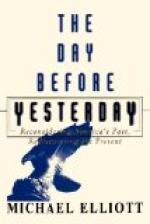Traces of the witty early nineteenth century still lingered into the “seventies,” “eighties,” and “nineties.” Lady Constance Leslie, who is still living, and the late Lady Cork were almost the last descendants of the brilliant wits of Sydney Smith and Theodore Hook’s days. The hurry of modern life, and the tendency of the age to scratch the surface of things only, are not favourable to the development of this type of keen intellect, which was based on a thorough knowledge of the English classics, and on such a high level of culture as modern trouble-hating women could but seldom hope to attain. Time and time again I have asked Lady Cork for the origin of some quotation. She invariably gave it me at once, usually quoting some lines of the context at the same time. When I complimented her on her wonderful knowledge of English literature of the seventeenth and eighteenth centuries, she answered, “In my young days we studied the ‘Belles Lettres’; modern women only study ‘Belle’s Letters,’” an allusion to a weekly summary of social events then appearing in the World under that title, a chronicle voraciously devoured by thousands of women. When the early prejudice against railways was alluded to by some one who recalled the storms of protest that the conveyance of the Duke of Sussex’s body by train to Windsor for burial provoked, as being derogatory to the dignity of a Royal Duke, it was Lady Cork who rapped out, “I presume in those days, a novel apposition of the quick and the dead.” A certain peer was remarkable alike for his extreme parsimony and his unusual plainness of face. His wife shared these characteristics, both facial and temperamental, to the full, and yet this childless, unprepossessing and eminently economical couple were absolutely wrapped up in one another; after his death she only lingered on for three months. Some one commenting on this, said, “They were certainly the stingiest and probably the ugliest couple in England, yet their devotion to each other was very beautiful. They could neither of them bear to part with anything,




